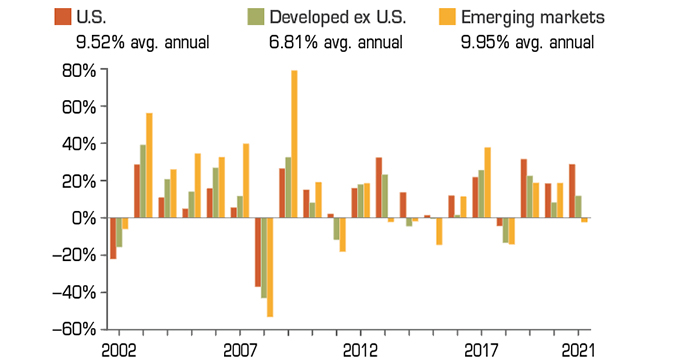Diversifying Your Portfolio with International Flair
Global economic growth is projected to drop from an estimated 6.1% rate in 2021 to 3.2% in 2022, as the world grapples with repercussions from the Russia-Ukraine war and ever-changing conditions wrought by the pandemic. Growth forecasts of 2.3% for the United States and 2.6% for the euro area in 2022 (down from 5.7% and 5.4%, respectively, in 2021) reflect the prospect of supply constraints along with rising inflation and interest rates. China’s growth is projected to slow to 3.3% in 2022 from 8.1% in 2021 due to its restrictive zero-COVID strategy and languishing real estate sector.1

Investing internationally provides access to growth opportunities outside the United States, which may boost returns and/or enhance diversification in your portfolio. But foreign securities carry additional risks that may result in greater share price volatility; these risks should be carefully managed with your goals and risk tolerance in mind.
Foreign Factors
It’s often more complicated for investors to perform due diligence and identify sound investments in unfamiliar and less transparent foreign markets. Plus, there are potential risks that may be unique to a specific country.
Politics and economic policies. A nation’s political structure, leadership, and regulations may affect the government’s influence on the economy and the financial markets.
Currency exchange. If a domestic currency is strong against a foreign currency, an investor could gain purchasing power when exchanging to the weaker currency. However, if the foreign currency continues to weaken, any investment gains and the principal may lose value when exchanged back to the domestic currency.
Financial reporting. Many developing countries do not follow rigorous U.S. accounting standards, which often makes it more difficult to have a true picture of company and industry performance.
Global Strategies
A relatively simple way to gain entry to foreign markets is with mutual funds or exchange-traded funds (ETFs). The term “ex U.S.” or “ex US” typically means that the fund does not include domestic stocks, whereas “global” or “world” funds may include a mix of U.S. and international stocks.
International funds range from broad global funds that attempt to capture worldwide economic activity, to regional funds and others that focus on a single country. Some funds are limited to developed nations, whereas others concentrate on nations with emerging (or developing) economies. The stocks of companies located in emerging nations might offer greater growth potential, but they are quite a bit riskier and less liquid than the stocks of companies located in more advanced economies. For any international stock fund, it’s important to understand the mix of countries represented by the underlying securities.
Global Performance Picture
Over the past 20 years, stocks in emerging markets have slightly outperformed U.S. stocks but have been much more volatile. Stocks of developed economies outside the United States have lagged domestic stocks over the 20-year period by a wide margin, but still outperformed in nine of those 20 years.
Stock market performance, 2002–2021 (annual total returns and average annual returns)

Source: Refinitiv, 2022, for the period 12/31/2001 to 12/31/2021. U.S. stocks are represented by the S&P 500 Composite Total Return Index, developed ex U.S. stocks are represented by the MSCI EAFE GTR Index, and emerging market stocks are represented by the MSCI EM GTR Index; all are considered representative of their asset classes. The performance of an unmanaged index is not indicative of the performance of any specific investment. Individuals cannot invest directly in an index. Rates of return will vary over time, especially for long-term investments. Past performance is not a guarantee of future results. Actual results will vary.
It may be tempting to increase your exposure to a booming foreign market, however chasing performance might cause you to buy shares at high prices and suffer more severe losses when conditions shift. If you decide to spread your investment dollars around the world, be prepared to hold tight during bouts of market volatility. Still, you should rebalance your portfolio periodically to help ensure that your exposure to international stocks has not drifted too far from your intended allocation — to the detriment of your long-term investment strategy.
Investors should keep in mind that selling investments in a taxable account could result in a tax liability. Diversification is a method used to help manage investment risk; it does not guarantee a profit or protect against investment loss. The return and principal value of all stocks, mutual funds, and ETFs fluctuate with changes in market conditions. Shares, when sold, may be worth more or less than their original cost. Supply and demand for ETF shares may cause them to trade at a premium or a discount relative to the value of the underlying shares.
Mutual funds and ETFs are sold by prospectus. Please consider the investment objectives, risks, charges, and expenses carefully before investing. The prospectus, which contains this and other information about the investment company, can be obtained from your financial professional. Be sure to read the prospectus carefully before deciding whether to invest.
1) International Monetary Fund, 2022
This information is not intended as tax, legal, investment, or retirement advice or recommendations, and it may not be relied on for the purpose of avoiding any federal tax penalties. You are encouraged to seek guidance from an independent tax or legal professional. The content is derived from sources believed to be accurate. Neither the information presented nor any opinion expressed constitutes a solicitation for the purchase or sale of any security. This material was written and prepared by Broadridge Advisor Solutions. © 2022 Broadridge Financial Solutions, Inc.
